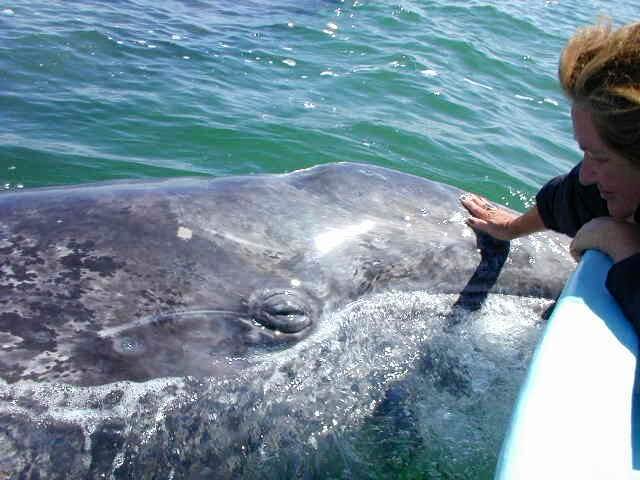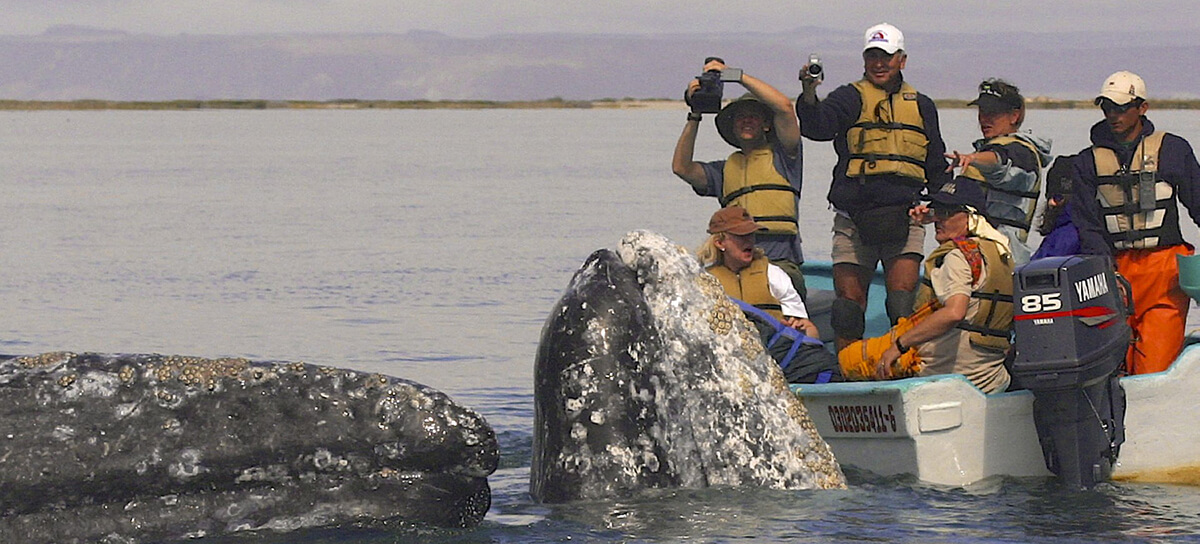We jostle and shake for four hours as we slowly make our way out to the lagoon. My daughter, Jennifer and I are travelling to see what the locals call the “desert whales” of Mexico. It is March and the road is wet and often divides into several tracks. Johnny, our driver, proceeds cautiously, as he knows repairs take time and parts are not readily available in this remote area of the Baja Peninsula. For over 12 years, Johnny Friday has driven this road to Campo Cortez at San Ignacio Lagoon, on the Pacific coast. He developed a friendship and eventually a partnership with a local fisherman, Maldo Ficher. Together they built a nature retreat on the remote desert lagoon and formed a whale watching business, the Baja Ecotours.
 We stop at the side of the road for a drink and a stretch. I quickly snap off a roll of film. We were amazed at the diversity of cactus along our journey across the Baja Peninsula. The world’s tallest cactus, the Cordon cactus, grows to 60 feet, and often dominates the landscape. Dr. Marie Dalcourt, our naturalist for the trip, advises that there are several hundred species of cactus found in this desert region, ranging from giant barrel cactus to the rambling growth of the Galloping Cactus. The Mexican Fence Post cactus is often planted in rows to make a living fence. Mexico has more species and specimens of cactus than any other country in the world.
We stop at the side of the road for a drink and a stretch. I quickly snap off a roll of film. We were amazed at the diversity of cactus along our journey across the Baja Peninsula. The world’s tallest cactus, the Cordon cactus, grows to 60 feet, and often dominates the landscape. Dr. Marie Dalcourt, our naturalist for the trip, advises that there are several hundred species of cactus found in this desert region, ranging from giant barrel cactus to the rambling growth of the Galloping Cactus. The Mexican Fence Post cactus is often planted in rows to make a living fence. Mexico has more species and specimens of cactus than any other country in the world.
Our excitement grows as a row of white canvas tents come into view. They are situated on a low bank at the edge of the water. This is to be our base camp for the next few days as we journey out into the lagoon to view the Gray whales. San Ignacio Lagoon is famous for it? friendly whales and we wonder if we will have the good fortune to rub and scratch one of these giants. The lagoon is one of the few undeveloped breeding grounds for Gray whales, a haven before they make their long annual migration north to the Bering Sea to feed. This 10,000 km trip is the longest migration of any mammal.
Jennifer and I have often witnessed the Gray whales in the spring as they quickly passed by Vancouver Island on their way north. There is an active whale watching industry on the west coast of Vancouver Island that views 35 to 50 Gray whales that do not migrate any farther north than Vancouver Island. They spend the spring and summer feeding on herring spawn, a variety of planktonic animals in the water and ghost shrimp and worms from the sea floor. The Gray whale is the only whale known to feed on the bottom, rolling on its side and scooping up a mouthful of sand and mud. Dr. Jim Darling and underwater photographer Flip Nicklin confirmed that the massive tongue acts as a plunger, first to vacuum up the sediment and then to force the water and mud out through the baleen plates to screen out a meal.
As evening falls, we meet in the dining hut or palapa for a margarita, followed by a wonderful dinner of tortilla shells, beans, rice and local fish. We plan to set off to our tent for the night and Johnny reminds Jen and me to shake our shoes in the morning, a precaution to avoid the wrath of the local scorpions. As we step outside the palapa, we hear the nearby bark of coyotes. Marie convinces Jennifer that the coyotes are small and not at all aggressive. Together they trek to the outhouse and Jen exclaims on their return “I saw their eyes shining in the beam of my flashlight, but as soon as I got near they ran away into the desert”.
We reach our tent containing two cots sitting on the sand with a runner of carpet between them. I lay on my cot, cold in my sleeping bag, and listen to the coyotes.
It sounds like another fishing story. Mexican handbook recounts how the coyotes in Baja occasionally fish for crabs. “The coyote? furry tail is placed in the water, waiting for a crab to grab on.. Then, with a flick of the tail, the crab is tossed ashore. Before the crab can recover from the shock, the coyotes are busy enjoying a fine crab feast”.
When the lagoon is calm, the powerful blows of the whales often interrupt the quiet. Not tonight! The wind soon begins to whip our tent and I stumble out in the night to fasten any loose bits of tent that I can stretch and tie down. I shiver as I crawl back into my down bag, remembering the brochure refers to this as “safari style ambience”.
I wake to an orange light bursting through the walls of the canvas. I open the front flap of the tent and watch the sun rise over the lagoon from my cot. A variety of shore birds strut along the beach, feeding on the banquet exposed on the mudflats by the low tide. I recognize Brant geese, a reminder of home. The Brant Geese Festival at Parksville, on the east coast of Vancouver Island, celebrates the annual return of these geese each spring, where they feed along the rich shores.
Immediately after breakfast, Jen, Zack, Marie and I join Maldo, our whale watching guide, and walk out to the small point. This is Zack? first trip also. A kayaker from New England, he jumped at the offer of a job as nature guide and kayak leader at the camp. A small fibreglass boat, or panga, is anchored just off a rocky outcrop and Maldo hauls the rope and brings the panga to shore. We board and set off with great anticipation.
Maldo? face breaks into a grin as we round the point and a Gray whale breaches in the distance. “Watch,” he says, “they always breach three times in a row. One time, a whale breached eight times in a row!” Sure enough, twice more the whale rises out of the water, turns and lands with a great splash.
Maldo stands at the stern of the boat and holds the steering arm and controls of the motor. He slows the panga as we approach a large mother, almost 50 feet long, and her calf.
 “Splash water at them,” Marie cries, “she will bring her baby.” Soon the large mother and her calf slowly approach the boat. A gentle lifting of the boat as the whale rubs up and under the boat makes us a little nervous, all except for Maldo.
“Splash water at them,” Marie cries, “she will bring her baby.” Soon the large mother and her calf slowly approach the boat. A gentle lifting of the boat as the whale rubs up and under the boat makes us a little nervous, all except for Maldo.
“I haven’t had anyone land in the water yet,” he says with a reassuring smile.
The mother raises her large head at the side of the boat and patiently rests as we rub and scratch her back.
Marie cautions “Do not touch the eye, blowhole or fins of the whale.This will disturb them.”
The mother constantly swims immediately below her calf, and gently moves the calf towards the boat for a greeting. A burst of bubbles rises to the surface. We are not sure if this behaviour, called bubble blasting, is a greeting or a sign of aggression. The head of the calf rises out of the water to expose a large eye, shutters click and there are cries of excitement. I shoot many frames and capture Jen and Zack? first time rubbing and scratching the back of the calf. I wonder what other wild animal would bring its young to humans for contact?
Jen smiles and says “This is awesome, Dad!”
How different this is to the aggression of the mother whales and the harrowing experiences of whalers in earlier times on these breeding grounds that caused them to call these whales “hard-head” and the “devil-fish”. Charles Scammon, the 19th century whaler, explains in his book Marine Mammals of the North-Western Coast, that the most dangerous whaling was in the lagoons. The names “arose from the fact of the animals having a great propensity to root the boats when coming in contact with them, in the same manner that hogs upset their empty troughs”.
He chronicled the cruel practice of harpooning calves first in order to draw the mothers within “darting distance”. The enraged mothers chased the boats and “hardly a day passes but there is an upsetting or staving of boats, the crews receiving bruises, cuts and in many instances, having limbs broken”. It is for good reason that the only boats allowed in the lagoon are those guided by the local fishermen.
On this day, we do not feel threatened at all by these giants. We look into the clear water and see that the mother? head and body is decorated with clusters of barnacles, a species that grows exclusively on these whales. What seemed at first to be pink patches are, at closer examination, small crab-like crustaceans known as whale lice. Gray whales are known to be the most encrusted of all the whales. We slowly move off as another panga approaches and it is their turn to interact with the whales.
Maldo tells us as we move away, “We take turns counting the whales each week as they arrive in December. By the end of March there may be as many as 300 whales in the lagoon.”
As we race to the outer reaches of the lagoon, suddenly a small group of bottlenose dolphins joins us to play and ride the bow waves of the panga. Then, just as quickly they depart. Brown pelicans bob up and down on the waves. Soon, the tell-tale heart shaped blows of the Gray whales lead us to another group. One “spyhops”, gently rising straight out of the water to get a better look at the visitors. We move to investigate a group of whales on the surface creating a great deal of splashing.
“This appears to be mating behaviour,” says Maldo. “Mating usually involves several whales, but it is surprising to see a female with a calf engaged in mating.” Marie adds “The gestation period is 12 to 13 months and a female will have a calf every other year.”
We all groan as Maldo announces it is time to return to the camp for lunch. Our spirits are high as the boat heads towards camp. Jen and I smile at each other and we realize we have had an unforgettable day together with the friendly Gray whales of San Ignacio Lagoon.
Some fast facts about Gray whales
Gray whales have been one of few success stories of recovery after whaling, which was banned in 1947. Their population has grown from a low of 2,000 to their former numbers in excess of 25,000 animals. There are still many threats, however, from pollution, disruption of their migration, oil and gas exploration, and industrialization of the breeding grounds. Dick Russell in his new book, “Eye of the Whale”, describes the many pressures currently facing the Gray whale. San Ignacio Lagoon, a wildlife reserve since 1979, was recently threatened by a proposed development of a saltworks by the Mexican government and the Mitsubishi Corporation. International pressure caused the government to withdraw its support and maintain this undisturbed wildlife refuge.
Gray whales, Eschrictius robustus, are also commonly known as desert whales, devilfish for their aggressive behaviour to protect their young, and mussel or mud digger, referring to their feeding behaviour of digging into sandy-mud bottoms.
Gray whales have paired blowholes on their head and plates of baleen hanging from the upper jaw to strain out food from the water. They do not have a dorsal fin, only a low hump and a series of 6 to 12 knobs along their back. Males grow to 14.6 m (48 ft). Females grow to 14.9 m (50 ft.) and 35 tons and their calves when born are 5m (15 ft.) long and weigh 900 kg or more.
By Rick Harbo
Nanaimo, BC Canada
Original post from 2002
Reading resources
Eye of the Whale. Dick Russell. 2001. Simon & Shuster. New York.
The Gray Whale. Eschrictius robustus. 1984. Edited by M.L. Jones, S.L. Swartz and S. Leatherwood. Academic Press. New York.
The Gray Whale. p. 20- 33 In The Marine Mammals of the North-Western Coast of North America, Together with an Account of the American Whale Industry. C.H. Scammon. 1874.
Baja California Plant Field Guide. Norman Roberts. 1989. Natural History Pub. Co.
Copyright Rick Harbo, 5745 Alder Way, Nanaimo, B.C. V9T 544 CANADA 250- 758-9492; E-MAIL rharbo@island.net; fax 250-758-4976



